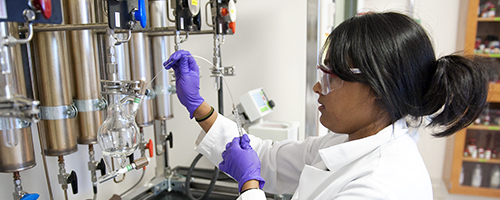Characterization of a broadly specific cadaverine N-hydroxylase involved in desferrioxamine B biosynthesis in Streptomyces sviceus
This document has been relocated to https://scholarworks.smith.edu/chm_facpubs/53/
Abstract
N-hydroxylating flavin-dependent monooxygenases (FMOs) are involved in the biosynthesis of hydroxamate siderophores, playing a key role in microbial virulence. Herein, we report the first structural and kinetic characterization of a novel alkyl diamine N-hydroxylase DesB from Streptomyces sviceus (SsDesB). This enzyme catalyzes the first committed step in the biosynthesis of desferrioxamine B, a clinical drug used to treat iron overload disorders. X-ray crystal structures of the SsDesB holoenzyme with FAD and the ternary complex with bound NADP+ were solved at 2.86 Å and 2.37 Å resolution, respectively, providing a structural view of the active site environment. SsDesB crystallized as a tetramer and the structure of the individual protomers closely resembles the structures of homologous N-hydroxylating FMOs from Erwinia amylovora (DfoA), Pseudomonas aeruginosa (PvdA), and Aspergillus fumigatus (SidA). Using NADPH oxidation, oxygen consumption, and product formation assays, kinetic parameters were determined for various substrates with SsDesB. SsDesB exhibited typical saturation kinetics with substrate inhibition at high concentrations of NAD(P)H as well as cadaverine. The apparent kcat values for NADPH in steady-state NADPH oxidation and oxygen consumption assays were 0.28 ± 0.01 s-1 and 0.24 ± 0.01 s-1, respectively. However, in product formation assays used to measure the rate of N-hydroxylation, the apparent kcat for NADPH (0.034 ± 0.008 s-1) was almost 10-fold lower under saturating FAD and cadaverine concentrations, reflecting an uncoupled reaction, and the apparent NADPH KM was 33 ± 24 μM. Under saturating FAD and NADPH concentrations, the apparent kcat and KM for cadaverine in Csaky assays were 0.048 ± 0.004 s-1 and 19 ± 9 μM, respectively. SsDesB also N-hydroxylated putrescine, spermidine, and L-lysine substrates but not alkyl (di)amines that were branched or had fewer than four methylene units in an alkyl chain. These data demonstrate that SsDesB has wider substrate scope compared to other well-studied ornithine and lysine N-hydroxylases, making it an amenable biocatalyst for the production of desferrioxamine B, derivatives, and other N-substituted products.


